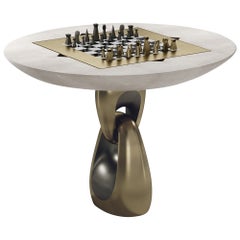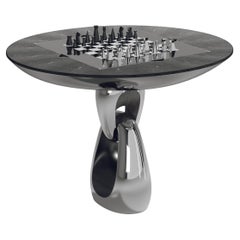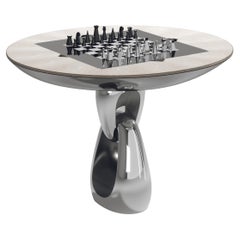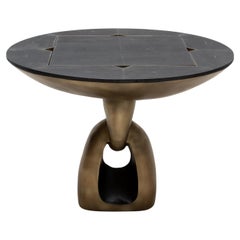Saturn Game Table By Augousti
21st Century and Contemporary Philippine Art Deco Game Tables
Brass
21st Century and Contemporary Philippine Art Deco Game Tables
Brass, Stainless Steel, Chrome
21st Century and Contemporary Philippine Art Deco Game Tables
Brass, Stainless Steel, Chrome
21st Century and Contemporary Philippine Art Deco Game Tables
Brass
Recent Sales
21st Century and Contemporary Philippine Art Deco Game Tables
Brass
People Also Browsed
21st Century and Contemporary Contemporary Color Photography
Plexiglass, Archival Paper, Photographic Paper, Photographic Film
21st Century and Contemporary American Modern Magazine Racks and Stands
Acrylic, Lucite
2010s Dutch Modern Wall Mirrors
Foil
2010s Portuguese Modern Carts and Bar Carts
Metal
Vintage 1940s French Art Deco Vanities
Mirror
Vintage 1960s French Mid-Century Modern Armchairs
Fabric, Wool, Upholstery, Velvet, Rope, Plywood
21st Century and Contemporary Italian Mid-Century Modern Dining Room Chairs
Velvet, Beech
2010s Italian Organic Modern Commodes and Chests of Drawers
Brass
21st Century and Contemporary Mexican Organic Modern Floor Lamps
Brass
2010s American Modern Cabinets
Brass
Vintage 1980s Italian Mid-Century Modern Game Boards
Lapis Lazuli
21st Century and Contemporary Philippine Art Deco Abstract Sculptures
Brass
2010s American Modern Beds and Bed Frames
Upholstery, Velvet, Hardwood, Maple
21st Century and Contemporary Philippine Art Deco Abstract Sculptures
Brass
Vintage 1970s French Side Tables
Glass, Wood
Vintage 1930s Finnish Art Deco Chandeliers and Pendants
Metal, Brass
R & Y Augousti for sale on 1stDibs
R&Y Augousti was founded in 1989 by husband-and-wife team Ria and Yiouri Augousti. The pair works with pen shell, metal and an array of exotic skins — including ostrich, snake, eel and crocodile — to create Art Deco-inspired furniture that echoes the influences of their unique friends and draws on the experiences they’ve shared on their global travels.
Ria Augousti (née Macasaet) was born in Manila. Her family relocated to Cebu and, at age 15, she went to New York City to study art. She continued her studies in England and graduated from the London School of Furniture Making.
Born in Cyprus, Yiouri Augousti studied architecture at London’s Architectural Association. He was drawn to interior design that reflected a revival of Art Deco that took shape during his years as a young adult.
Ria was working at the interior design firm of John Stefanidis, in London, when Yiouri joined the firm. “We got on like a house on fire,” Ria has said of the beginnings of their relationship. The couple established R&Y Augousti in 1989 and married in 1990. The business grew swiftly — R&Y Augousti moved permanently to Paris in 1994, and in 2011, the couple opened their first American showroom. There, in the New York Design Center, the range of decorative objects on offer from R&Y Augousti included dining tables, side tables and decorative objects such as candleholders and picture frames in shagreen.
The initial popularity that shagreen enjoyed as furniture covering fizzled when the Art Deco era faded. Modernist designer Jean-Michel Frank was an enthusiast of the textured hide, and during the 1960s, Karl Springer covered desks, chairs and tables with it. Ria Augousti wanted to revive shagreen’s use as a finish in one of their very first designs. Their sculptural, sensuous shagreen Sylvie chair, with its slender and towering backrest, makes a statement in any space and has seen a fair amount of praise over the years. The Sylvie has been photographed in a number of high-profile spaces including Alexander Wang's New York City loft apartment designed by Ryan Korban. (And shagreen reemerged as a luxe material among designers and decorators in 2017.)
R&Y Augousti has since expanded into fashion accessories, and drawings by the couple’s daughter, designer Kifu Augousti, have been embroidered on some of the brand’s luxurious handbags.
Find R&Y Augousti tables, seating and decorative objects on 1stDibs.
A Close Look at Art-deco Furniture
Art Deco furniture is characterized by its celebration of modern life. More than its emphasis on natural wood grains and focus on traditional craftsmanship, vintage Art Deco dining chairs, tables, desks, cabinets and other furniture — which typically refers to pieces produced during the 1920s and 1930s — is an ode to the glamour of the “Roaring Twenties.”
ORIGINS OF ART DECO FURNITURE DESIGN
- Emerged in the 1920s
- Flourished while the popularity of Art Nouveau declined
- Term derives from 1925’s Exposition Internationale des Arts Décoratifs et Industriels Modernes (International Exhibition of Modern Decorative and Industrial Arts) in Paris, France
- Informed by Ancient Egypt, Cubism, Futurism, Louis XVI, De Stijl, modernism and the Vienna Secession; influenced Streamline Moderne and mid-century modernism
CHARACTERISTICS OF ART DECO FURNITURE DESIGN
- Bold geometric lines and forms, floral motifs
- Use of expensive materials such as shagreen or marble as well as exotic woods such as mahogany, ebony and zebra wood
- Metal accents, shimmering mirrored finishes
- Embellishments made from exotic animal hides, inlays of mother-of-pearl or ivory
ART DECO FURNITURE DESIGNERS TO KNOW
VINTAGE ART DECO FURNITURE ON 1STDIBS
Few design styles are as universally recognized and appreciated as Art Deco. The term alone conjures visions of the Roaring Twenties, Machine Age metropolises, vast ocean liners, sleek typography and Prohibition-era hedonism. The iconic movement made an indelible mark on all fields of design throughout the 1920s and ’30s, celebrating society’s growing industrialization with refined elegance and stunning craftsmanship.
Widely known designers associated with the Art Deco style include Émile-Jacques Ruhlmann, Eileen Gray, Maurice Dufrêne, Paul Follot and Jules Leleu.
The term Art Deco derives from the name of a large decorative arts exhibition held in Paris in 1925. “Art Deco design” is often used broadly, to describe the work of creators in associated or ancillary styles. This is particularly true of American Art Deco, which is also called Streamline Moderne or Machine Age design. (Streamline Moderne, sometimes known as Art Moderne, was a phenomenon largely of the 1930s, post–Art Nouveau.)
Art Deco textile designers employed dazzling floral motifs and vivid colors, and while Art Deco furniture makers respected the dark woods and modern metals with which they worked, they frequently incorporated decorative embellishments such as exotic animal hides as well as veneers in their seating, case pieces, living room sets and bedroom furniture.
From mother-of-pearl inlaid vitrines to chrome aviator chairs, bold and inventive works in the Art Deco style include chaise longues (also known as chaise lounges) and curved armchairs. Today, the style is still favored by interior designers looking to infuse a home with an air of luxury and sophistication.
The vintage Art Deco furniture for sale on 1stDibs includes dressers, coffee tables, decorative objects and more.
Materials: Brass Furniture
Whether burnished or lacquered, antique, new and vintage brass furniture can elevate a room.
From traditional spaces that use brass as an accent — by way of brass dining chairs or brass pendant lights — to contemporary rooms that embrace bold brass decor, there are many ways to incorporate the golden-hued metal.
“I find mixed metals to be a very updated approach, as opposed to the old days, when it was all shiny brass of dulled-out silver tones,” says interior designer Drew McGukin. “I especially love working with brass and blackened steel for added warmth and tonality. To me, aged brass is complementary across many design styles and can trend contemporary or traditional when pushed either way.”
He proves his point in a San Francisco entryway, where a Lindsey Adelman light fixture hangs above a limited-edition table and stools by Kelly Wearstler — also an enthusiast of juxtapositions — all providing bronze accents. The walls were hand-painted by artist Caroline Lizarraga and the ombré stair runner is by DMc.
West Coast designer Catherine Kwong chose a sleek brass and lacquered-parchment credenza by Scala Luxury to fit this San Francisco apartment. “The design of this sideboard is reminiscent of work by French modernist Jean Prouvé. The brass font imbues the space with warmth and the round ‘portholes’ provide an arresting geometric element.”
Find antique, new and vintage brass tables, case pieces and other furnishings now on 1stDibs.
Finding the Right Game-tables for You
Bring drama and duels of dexterity into your home with vintage, new and antique game tables for every kind of game.
Who doesn’t love a little competition? Historians estimate that early versions of games such as backgammon were played by members of ancient civilizations at least as far back as 3,000 B.C. Chess, which likely originated in India as a game called chaturanga, is a timeworn test of skills and strategy as well, and the modern era’s iteration of the game was enjoyed by nobles at least as early as the 16th century.
While the upper classes in Europe were among the only chess players who could afford the game’s decoratively carved ivory pieces, the game eventually became accessible to the general public. In the late 19th century, the game’s first official chess championships took place, a realm that eventually produced celebrated players such as avowed Eames Executive chair enthusiast Bobby Fischer. Today, antique chessboards have seen an uptick in demand owing to a successful Netflix series in 2020 called The Queen’s Gambit, which chronicles the life of fictional chess prodigy Beth Harmon.
Modern versions of chess boards and other home game tables may have evolved to accommodate the variety of games for which they’re used but are still versatile pieces of furniture. Not every card table with chairs is the ideal dining table, but you certainly don’t have to limit a game table to recreational use.
Antique trictrac tables, for example, were products of 18th-century France, wherein furniture makers created what looked like multipurpose neoclassical writing desks and card tables that when their tops were removed revealed trictrac, chess and checkers surfaces. Other game tables, in a complete commitment to fun, merely support good old-fashioned competition. Contemporary Ping-Pong (or table tennis) tables, which have origins in 1880s Victorian England, can be quite sophisticated in form and are made from a variety of materials today. A billiards table is an iconic piece for any game room or living room, but your pool table is really going to be used for only one thing, right?
Antique or new Regency-style game tables, mid-century modern tables or Art Deco–style card tables, perhaps fashioned from rosewood or mahogany, might be equipped with convertible tabletops to shift from meals to game time in a snap. If you prefer poker or opt for a card table topped with a checkerboard, convenient drawers and other compartments can be found in new and vintage game tables that fit poker chips or other types of game pieces perfectly.
Find a range of top-quality vintage and antique game tables on 1stDibs that can help you introduce a bit of class to every competition at home.




